|
Interview with
Xochimilco Zapatista and Puente a la Esperanza
Aide, Angelica and Victor
Where Dreams Can Be Created, Constructed
Mexico City, Mexico
|
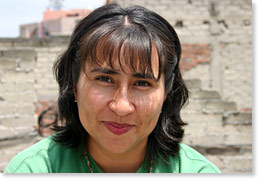 |
|
Aide. All photos by Nic Paget-Clarke.
|
|
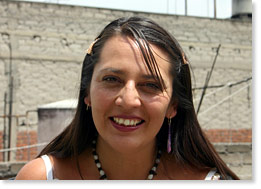 |
|
Angelica.
|
|
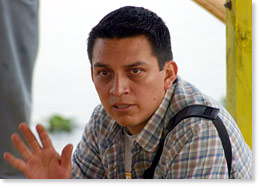 |
|
Victor.
|
|
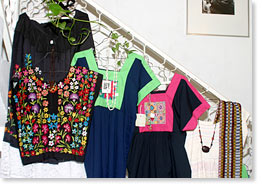 |
|
Some of the products for sale at the Casa de Todos Los Pueblos. |
|
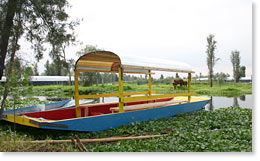 |
|
The Compañera Digna Ochoa trajinera among the gardens of Xochimilco.
|
|
 |
|
A ride on the trajinera.
|
|
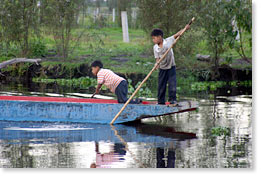 |
|
Children pass by in another boat.
|
|
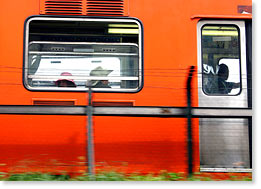 |
|
On the Metro, Mexico City.
|
|
 |
|
The Pyramid of the Sun, Teotihuacan, near Mexico City.
|
|
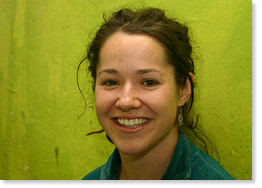 |
|
Brook Thompson.
|
The following interview was with a commission (Aide, Angelica and Victor) of members of Xochimilco Zapatista and Puente a la Esperanza. It was conducted (and later edited) by Nic Paget-Clarke for In Motion Magazine on September 3, 2005 in Mexico City, Mexico. Brook Thompson provided interpretation between Spanish and English. Concerning titles within their organizations, Victor said, “In organizations that we participate in, there aren’t really positions. We work as a collective and there is work.” Angelica added “Everything resolves itself through assembly. In the assemblies we discuss and we decide things. That is where we decide who is going to do what work.”
La Casa de Todos Los Pueblos
In Motion Magazine: Could you please say where we are, what building, what part of Mexico City?
Victor: We are in the Casa de Todos Los Pueblos / the House of All of the People, it’s for everyone. We are in Mexico City, the federal district, in the Colonia Obrero in the center of the city.
In Motion Magazine: How did this house come to be?
Angelica: The house was born in part to unite various Zapatista groups from around the city. We knew ourselves as Zapatistas with the armed uprising. We had worked for a long time in Chiapas building autonomy, but the people in the city said “Why is everything for Chiapas? What about the people in the city?” This is what all the collectives asked that had worked in Chiapas. We believed that it was important to build autonomy in the city. We began to talk with other groups to begin to build a space, a house that would serve as a place for us to meet, to share experiences, to do work together, where we could construct autonomy in the city, and where we could link ourselves and make more community.
The groups that belong are Xochimilco Zapatista, Puente a la Esperanza, Zapatistas de Nocalpan, and Sembrando Dignidad de Cayocan.
Just Commerce
Victor: The house also belongs to people who work with the National Indigenous Congress. Some compañeros bring products from their villages, communities, and they try to do “just commerce” in the city.
Products arrive at the house from the state of Michoacan and the state of Guerrero, from Oaxaca, Chiapas, Veracruz, Pueblo. They are all from compañeros who are in resistance, who are trying to build autonomy within their own communities. For example, CIPO, Consejo Indigenes Popular de Oaxaca , Pueblo Purepecha, even Mexico City.
Aide: There are also Zapatista groups from Chiapas who have products downstairs. The idea of the house is to not only to build this one house for all the people, but to build many houses all over the city because it is part of the movement for national liberation -- in cities all over Mexico, and all over the world.
The idea is not only to have this place of just commercialization for groups, but also to be a place where dreams can be created and constructed, a place of dreams. We are constructing another in the Chinampas, in the floating gardens, and that’s to be a caracol (like the caracoles of the Zapatistas in Chiapas). It’s a construction by everyone. One thing that is important is that if we don’t think collectively the struggle will not continue.
In Motion Magazine: What is just commercialization or just commerce?
Aide: In the past, things were bought in the communities at a very low price. For example, coffee was bought for one peso for a kilogram. But then it would be sold here for 90 pesos for a kilo, or more. This isn’t just (fair) for the producers or the consumers. The idea is that we can have a business without any intermediary people, that there is a just price for the producer and a just price for the consumer. With this we can begin to construct the links, the bridges, between the indigenous peoples and the people of the city -- to build autonomies, resistance towards the neoliberal project.
The neoliberal project
The neoliberal project wants to take the land of the indigenous and privatize their rivers, their forests. Many indigenous people leave as migrants because their products don’t make them money. This is what the transnational corporations want, to take the lands of the indigenous people. And then, to us, they bring products from the United States, including many products that are transgenic. We are left with these impossibilities. How can we survive, as far as our resources and the countryside of Mexico?
Angelica: The countryside of Mexico is being taken away. It’s being lost. We are getting our products from other countries. What we want to do is to strengthen, to help the indigenous so that they can keep making their products and they can bring them here and we will sell them in the city. This helps all of us. We are helped because we have better food to eat -- it’s from the countryside, it’s natural, it does not contain transgenics. They are helped because they are getting a better price, a more just price.
It’s a very large dream. That’s why Aide said that it’s not just building one house but many houses all over the city where people can bring products and sell them and have this exchange. The just commercialism, the just business is not only selling, it’s also sharing, having communication so that we know each other in our own country. It not only affects the farmers but also us as consumers -- so that we can construct another Mexico.
A new form of relations among everyone
Victor: It’s trying to reconstruct. The political parties have divided many people and they haven’t constructed a country where there is justice for everyone, where there are human rights for everyone. Zapatismo proposes another form in how we can relate to each other.
We can’t sit and have a cup of coffee without thinking about where that coffee comes from there is someone and they have a name, like Pedro or Rosa. Just commerce is not only an economic question it is a new form of relations among everyone. The compañeros who work as farmers, sometimes they give us a good price for the food, but they also demand that we do some type of project in their communities. It is a form of re-relating ourselves to one another and saying that I don’t exist without you.
Angelica: More than just the food, there’s also the artisan work, such as the embroidered blouses. We have a textile project in Zapatista communities. They are cooperatives of women, women of the Zapatista communities who meet as a self-consuming cooperative.
This is to say that, first, the women learn how to make clothing for their husbands, for their children, for themselves, for the community. In the communities a dress would sell for a hundred and twenty pesos. If I paid one peso for a kilogram of coffee, you couldn’t buy clothing with that. So the cooperatives began to organize themselves and they do this as self-consumption cooperatives. So they can sustain themselves, make clothing for themselves. But the second part is they begin to commercialize a bit and sell their clothing through the Casa de Todos Los Pueblos.
We have constructed together with the compañeras seven cooperatives in the Ricardo Flores Magon Municipio, which is in the region of Montezazules, and, more or less, these seven cooperatives serve sixty communities. It’s like Victor said, the work in the communities in just commerce is the idea that we work together.
Rescuing cultural dignity
Aide: It also has much to do with the cultural rescuing of our tradition, or our cosmovision. These embroidered blouses have a lot to do with the tradition of doing this artisan work. It gets back to our roots. For example, in this clothing each item has a tag that says who made it. It is getting to that root, a tradition that preserves the culture.
We are trying to rescue the dignity in our roots, our culture not only to show these artisan pieces as a mere folkloric piece of work, but as part of our roots made with a significance, a symbolism that has some type of feeling, some connection. We are trying to transmit that and rescue that.
Our struggle is part of not only just commerce but also the rescue, for example, of original grain from our land, of an embroidered blouse, a bracelet. It is rescuing these things and our cultural dignity.
Victor: Here in the outside real world, neo-liberalism is trying to make us all the same. But the roots of the indigenous people are present in all of Mexico. We come to our meal and eat tortillas from the corn that Rosa or Pedro planted in all of the villages of America, of Mexico. Cultural diversity, diversity of roots, is something that has survived in the communities. Mexico is, for the majority, indigenous with much tradition and a lot of memory. In the city, this memory is lost. To simply show that there exists another form of life is a proposal. The House of All the People, just commerce, shares the word, is a way of communication, of having a voice. It shows to the people of the city who have lost this memory that they do have roots and that we can touch, feel.
So we don’t die in this gray world
In Motion Magazine: Is just commerce the main work of La Puente a la Esperanza?
Angelica: It is just one of our projects. There are four main axes of our work at La Casa de Todos Los Pueblos. Those are political formation, information, culture -- which includes education and information -- and auto-gestion that is the commercialization part.
Victor: In each one of these forms of work, we form strategies respective to the situations that exist in the communities. For example, in Xochimilco, there is problem of the privatizing of land, of losing historical, cultural memory -- the breaking of the social weaving of the people, of the community. There are proposals for work in Xochimilco that have dignity. We have to see what proposals we can come up with among all of us.
Xochimilco is made up of a lot of different communities. Among the people they are creating proposals of work in which they are trying to involve all the people of the communities. From Xochimilco Zapatista the proposal is national liberation, not as a discourse but as construction from the bottom. This is a question to involve the four main forms of work of La Casa because with the communities there have to be community-style workshops, community diagnostics in order to know what it is that hurts the community and to be able to see among everyone in the entire community how it’s going to be resolved.
Some possible solutions include just commercialization, but that is not the only one, there’s also occupying the land, rescuing the culture. Commercialization is what you see most, but information as well. There is also an intention to do alternative media -- inside the community but also outside. It is to share what is happening there, to share it with the outside, to transmit that.
Each one of the collectives has work in their communities. For each one they have to look and see in which area they have to strengthen more. Some are more into political formation, but there is also education, reflection, or even something like learning how to use a computer, the things that we have to do daily.
Similarly, there are compañeros who write poetry, who do art, who take photos. We believe that culture is an important thing so that we don’t die in this gray world. If the culture dies we are all going to die.
These are things you don’t see much of. They don’t attract your attention. But this process is creating itself. It’s growing in many communities.
Autonomous education
Angelica: Another aspect of what we are talking about is there are groups that work in education in Chiapas. The education projects concern a different education, an autonomous education. Zapatista education in Chiapas looks to resolve the problems that they have. For example, where I work, in Ricardo Flores Magon, the main focus is on the Zapatista demands -- land, housing, health, nutrition, work, freedom, democracy, and justice -- there are eleven demands.
What we do is we work together with the promoters in regards to these Zapatista demands to create solutions from this autonomy. The education that I speak of is important for all the collectives because we go to Chiapas and work with the promoters of the EZLN. The promoters of education are like teachers; they go to the communities and give classes to the children. They are called promoters because they go to the communities and promote education, promote knowledge and growing, sharing that. But it is an exchange, not just going there to teach something and only having it be a one-way thing. It is a horizontal exchange.
Victor: Knowledge doesn’t just come from the promoter. True education doesn’t just come from the school. It comes from the family, from the grandparents who have spoken to the parents and the parents who speak to the children. The children share this knowledge with the promoters. They create a much larger knowledge.
Angelica: There is a center of education where the promoters go to prepare, to study for what they are going to teach. Afterwards, they go to their communities, to the autonomous schools. In the autonomous schools, this is where they share the knowledge with the children, with the adults.
Autonomous education talks about the rights of indigenous people. It talks about neo-liberalism; the neo-liberal projects that want to take the land from the indigenous people. It talks about the war in which the communities live which is a low-intensity war that the Mexican government is waging against the Zapatistas in order to end their organizing work.
Autonomous education is important because it gives knowledge and the motivation to continue being Zapatista, in organizing in that way.
What has happened in the federal schools in Chiapas and all over Mexico is that education has prohibited them to speak their native languages. They want that they forget the Tzetzal, the Tzotzil, the Chol, the Purepecha in Michoacan -- there are 72 languages. They say “Speak Spanish”. They obligate them to speak Spanish and want that they forget their culture and their traditions as well. They never recognize the Zapatistas. They never talk about Zapatismo. They ignore that it even exists, as well as any other social struggle. Autonomous education speaks about all this that the government does not talk about.
Autonomous education is not only to work in education in Zapatista communities in Chiapas, but it is also to work in this true education in our own collectives in the city.
In Chiapas, in Chihuahua, in all of Mexico
Victor: Education is part of the national liberation project of the Zapatistas. We believe that each of us is part of history. Each one of us has a work that we must do. We have to support the construction of something larger. The government says only what it wants regarding history. We are saying that history is much larger than that. Each history of each one of us is important, even though there isn’t a book about it. If it is not presented in a book it doesn’t mean that it doesn’t exist. What we are saying is that we have to recover our history and decide where we want to go. The importance of this true education in Chiapas, in Chihuahua, in all of Mexico is that it is asking, “What do we want to do?” “What do we want to be?” being part of this history, not being excluded.
Angelica: The Mexican federal government has taken advantage of indigenous people through history by exploiting them. To them the indigenous are those in the museum of anthropology. They are not those who are alive and who are organizing; those who are embroidering blouses; those who use the ski mask. Autonomous education looks to return life to all of us and to recognize us as part of this larger history. We want to rescue and recuperate but we also want to construct.
Xochimilco
In Motion Magazine: How many people are in the communities you work with?
Victor: It is complicated.
Aide: In Xochimilco Zapatista, for example, there is an assembly of twenty people from different pueblos and barrios who are housewives, campesinos, students, maids, workers. But also Xochimilco Zapatista works with other collectives and assemblies in Xochimilco, as well as having our own assembly. We are trying to make a network, linking ourselves in a struggle, working on the main areas of work mentioned earlier. It is a way of building these affinity groups and strengthening our community.
Victor: (Draws a diagram of the different assemblies and their interconnections.)
Aide: In Xochimilco Zapatista, there are 20 permanent representatives but each person has a family and they have other families or neighbors or they also represent another assembly. The difference of Xochimilco from the rest of Mexico City is that it still has this way of organizing itself, more like community organization. The social network still has a community style where it has the cultural festivals, celebrations, traditions that it still practices. This helps to unite the struggle.
In Motion Magazine: How many people live in Xochimilco?
Victor: One million.
Say there are fourteen communities. In the assembly there are people from eight of the fourteen communities. This work is known in those communities.
The indigenous peoples have territories. There are mountains and rivers and there are houses, but in all of this territory there’s communities that are in the mountains and everything that is within this community is theirs and they decide what happens to it. In each territory there are different communities. Within each pueblo there are various communities and each one has their own organization.
In the Xochimilco Zapatista assembly eight different representatives come from these various communities. Each representative comes to the assembly but then they return to their pueblo to disseminate this information. They bring proposals of work from their pueblo’s organization to the assembly of Xochimilco Zapatista. The assembly of Xochimilco Zapatista has a dynamic but then each organization of the pueblos has their own dynamic and we have to respect this at the same time because the need for some pueblos is the need for land, while for others it is to organize for the traditional festival.
Thus the grand area of Xochimilco is Zapatista.
That’s where Emiliano Zapata arrived. There he had military cartels during the Mexican revolution. There is a history in the pueblos regarding all of this. And so to assume Xochimilco as Zapatista is to bring the memory back of the pueblos, of these actual communities. Each indigenous community has had their historical process. This is to be recuperating. And sometimes this is to go and talk with the grandparents and to learn, above all, to know, to gain knowledge of how it produces itself in this moment.
Aide: There’s a lot of this in what we are working on right now, the trajinera and the chinampas. It is certain that neoliberalism is destroying all of this history. The government is pretending to erase all of this history, to negate it so we forget it. It is breaking all of these cultural and traditional links. But the work of Xochimilco Zapatista, in regards to the four main focuses of work, is focusing on rescuing culture.
Victor: Each one of the collectives has their own history and this is one.
Angelica: The Zapatista proposal is that a world exists where many worlds can exist. And so part of Casa is to respect the history of each collective and their forms of autonomous construction, their own spaces. Each collective has had a very long time of struggle working with the Zapatista proposals. It is so complex, difficult for us but also difficult for the government. The government doesn’t know who they should attack. If they should attack the indigenous or the women or the children or the history or the culture, the politics, or education. It is difficult for us but also for them. This is what makes the Zapatista demands so rich.
The trajinera and the chinampas
In Motion Magazine: Please describe the Compañera Digna Ochoa trajinera project in Xochimilco and why it is important.
Aide: The trajinera was constructed as a dream about four years ago so we could have trips with compañeros through the canals, among the chinampas (floating gardens). We could recuperate, recover our history first as a collective and second, share it with more people who would come to Xochimilco.
It arose also as an autogestion project where we could work with a just history and have a just trip in the trajinera. We could have resources to continue resisting and be able to distribute posters, information.
The major importance of this is that after four years, the trajinera, this project has made concrete the organizing of Xochimilco Zapatista. Now it is not just the trajinera but also an accompaniment to a floating garden and building the Zapatista caracol that will work for the same four points in Xochimilco. That is all in these two parts, the chinampa and the trajinera, which will do trips telling history.
Also, the trajinera was named for Digna Ochoa, a defender and lawyer of human rights who was assassinated. She was a lawyer for political prisoners. It was a decision of the compañeros to have the trajinera have her name.
1968 was a crossroads in Mexico
Victor: (When we talk about telling history,) Mexico is a country with a lot of history. The movements for land, for justice, for liberty formed a long time ago. The Mexican revolution happened in 1910. The Russian revolution was in 1917. The demands for justice aren’t new. But 1968 was a crossroads in Mexico. It was a very high point in all of the world, but in Mexico it was a breaking point.
There were a lot of workers’ and students’ movements which existed before the 1968 movements, but in 1968 there was a demonstration of tremendous brutality on the part of the government and the student social movements had two options: to resist the torture, the death, the persecution, or to go clandestine. There was a third option, to be part of the government, but this third option was saying that any movement for justice cannot exist.
We are children of the generations from this time (1968) and fortunately, through the social movements in Mexico and the armed struggle of the EZLN, there has been this ability to go on constructing this part of our history.
Many of the compañeros who were studying at this time left and went to communities in the countryside proposing other ways of life. The EZLN was formed through these groups that had to leave, who were the forces of national liberation, because there was no political path for the struggle for political rights. This path was repressed. In Mexico this is called the Dirty War when hundreds of men and women were disappeared, assassinated. But some resisted. They kept working, moving forward, working with organizations, with farmers, with communities. Also, there existed many armed groups in Mexico. All were struggling for justice, liberty and land. Each one had different forms in this struggle of resistance.
1968 to 1974 was a time when there wasn’t freedom. Now there still isn’t freedom, but in those years the repression was terrible. The government talks about 1968, but they don’t talk about, for example, 1971. There was a massacre of students and teachers in 1971 here near the Metro San Cozme. There are many histories that are not in the books. But they are in the conscience and memory of the people because they lived it. That’s why we talk about the grandfathers of Xochimilco who talk about Zapata.
History doesn’t stop. The movement of the people of Mexico doesn’t stop either.
Not taking power
Angelica: 1974 is important because in 1968 the thinking grew and then in 1974 the students arrived in the communities with this thinking. It’s what we are talking about in Xochimilco about seeing this with the indigenous community.
It is difficult for us to explain it. It’s difficult to understand it. But the same thing happened to the compañeros of ’68, when they arrived in the communities in’74. They had an idea of national liberation but through taking power, taking power and making the changes from there. The indigenous communities said, “We don’t want to take power. We want to live. There is no food. There’s a lot of illness. There is no education. There is no work. First we have to organize ourselves in order to create solutions for these basic needs.” And so began the Zapatista organizing.
Through campaigns for health, for literacy, through vaccination campaigns, through study circles where they talked with the people of the indigenous communities, they began to share experiences and organization.
I join myself with this movement that grew from 1968.
In Mexico, we talk about the perfect dictatorship because there wasn’t a coup like in Chile and Argentina. There’s a dirty war, they repress the people, but to the media we have a country where there is peace. Like Aide says, up to this point they haven’t clarified what happened in the massacre of Acteal, or in 1968, or 1971. There hasn’t been any punishment of this taking of human rights, of the torture, of the repression. And so, something that is very present is a fear of organizing.
We grew up with our parents who were from the time of 1968 and some say “Don’t get involved with this, with these movements, because they will massacre you.” This is something that is very difficult for organizing, when there is fear in the people. But since 1994 there has been hope.
1994 gave hope to many because it was lead by people who were marginalized so much and are so poor. Their capacity to organize against the government that represses them, seeing that shows us we can organize ourselves. Organize ourselves through culture, through politics, through the House of All the People in order to change this country and the world.
For more information / Para cualquier información:
Published in In Motion Magazine August 7, 2006
Also see:
- Interview with Gustavo Esteva
The Society of the Different
1 The Center of the World
2 We Are People of Corn
3 Regenerating Community
Oaxaca City, Oaxaca
- The Revolution of the New Commons
Gustavo Esteva
Oaxaca, Oaxaca, Mexico
- Interview with Rosy Barrios of La Red
Working to Rebuild Ourselves
San Cristóbal de Las Casas, Chiapas, Mexico
- Entrevista con Rosy Barrios de La Red
Trabajar Para Reconstruirnos
San Cristóbal de Las Casas, Chiapas, Mexico
- Interview with Raymundo Sánchez Barraza
A University Without Shoes
San Cristóbal de Las Casas, Chiapas, Mexico
- Entrevista con Raymundo Sánchez Barraza
Una Universidad Sin Zapatos
Sistema Indígena Intercultural de Educación no Formal
San Cristóbal de Las Casas, Chiapas, Mexico
- Interview with Geraldo Fontes of the MST
The Landless Rural Workers' Movement
“Without depending on power or having to take power”
Part 1 -- Building the New Society Now
Part 2 -- Agrarian Reform / Agribusiness
São Paulo, Brazil
- Interview with Miguel Angel Nuñez
Farmers are Demanding Agroecology:
Making Democracy Participative
Barinas and Caracas, Venezuela
- Interview with Pedro Reyes Millan
From Guerrilla Commander to Taparo Sculptor:
Art and production models which transfer knowledge
"Learning means dignity"
Barinas, Venezuela
- Interview with Nora Castañeda
of (Venezuela's) Women’s Development Bank
Caracas, Venezuela
- Interview with Severine Macedo
Youth Representative of FETRAF-SUL
Independent Alternatives for Rural Youth
Chapecó, Santa Catarina, Brazil
- Interview with Altemir Tortelli,
General Coordinator of FETRAF-SUL
"When Cooperative Structures Are The Instrument" and Autonomy
Chapecó, Santa Catarina, Brazil
|












